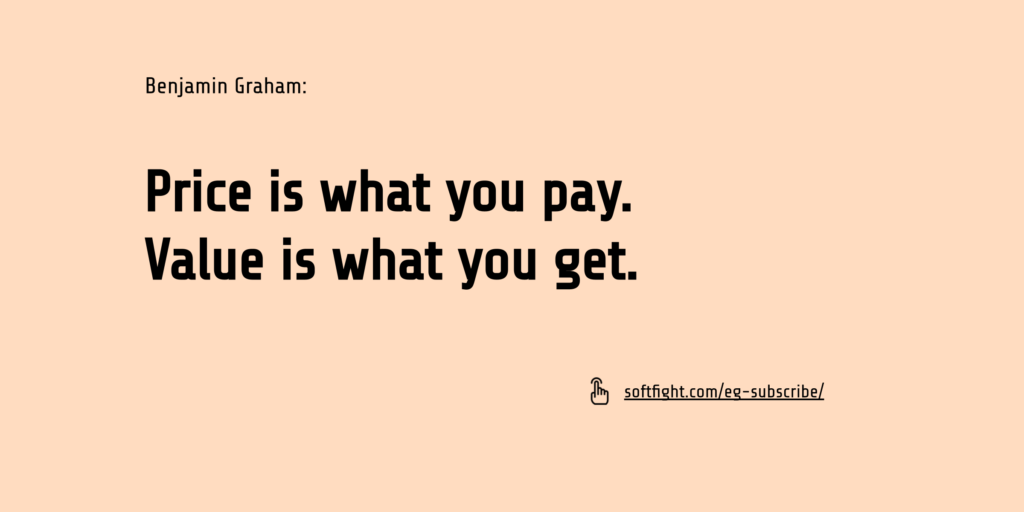I suspect you have already heard many times about value selling, value-based pricing or variations of these, either from me or from other people.
In theory, it sounds reasonable enough.
But what does it mean in practice?
What does it mean in a software services context?
What is the difference between value-based pricing (VBP) and cost-based (CB), if we look at the pricing journey, step by step?

Business Objectives
No difference here. Whether you want to increase volume, revenues or profits, the choice of objective is not dependent on whether you intend to use either VBP or CB.
Customer Segments
CB > companies using cost-based pricing don’t care too much about customer segmentation. Once they have calculated costs and decided on an acceptable profit margin on top, it doesn’t matter too much to them who will be buying, as long as they sell their services at the set prices.
VBP > with value-based pricing, customer segmentation becomes one of the critical components of the pricing architecture.
Different customers will value different services attributes.
Customers from different countries will have different capacity and willingness to pay, depending on their economic context and their expectations.
Companies from different industries will assign different economic values to the same problem, depending on the economics of their context.
People in different roles in a company will have different price thresholds, depending on their formal authority and position in the company.
These are just a few examples. There are many other variables that play a role in buying decisions in a B2B context.
For all these reasons, it’s almost impossible to do VBP without a careful analysis and a proper customer segmentation.
The result of this analysis is, at a minimum:
- a list of problems that customers need to solve
- how much they are willing to pay to have the problem solved by a vendor, as an estimated interval
- which services and attributes do the potential customers value, why and how much
Competition
CB > when prices are set based on costs, dealing with the competition is tricky.
Either you are constantly up against companies offering similar services or quality at lower prices, because they have a lower cost base. Many times this will push you to reduce your prices, leading to lower quality over time.
Or you will constantly see companies selling the same level of quality as you, but at significantly higher prices. Hoping to undercut them with lower prices, you will have an incentive to reduce prices, leading to lower quality over time.
VBP > once you have chosen your target customer segments, the next step is to understand who else is going after the same companies as you are.
It is also important to try and learn about the prices your competitors are charging, but also about the level of quality and which services they are capable of delivering.
It can help you a lot if you can build a realistic image of
- What customers are looking for
- What you can deliver
- What other competitors are delivering
Any gaps and misalignments that you can identify become opportunities for you to exploit to your advantage.
Pricing Strategies
CB > doesn’t leave a lot of room for maneuver when it comes to strategy.
It can work very well for a Market Penetration pricing strategy, if you are trying to sell high volumes at low prices AND you are able to constantly reduce your costs to remain competitive.
Pricing Skimming is when you start with a high price at launch and gradually reduce the price, as the total market grows or the product is replaced by more advanced versions. There might be some very specific contexts where this is applicable to Services, but I haven’t found them until now. And I don’t see how using cost-based pricing would be compatible with this strategy in software services.
The third basic pricing strategy is Revenue Maximization, when you try to get the maximum price out of each transaction. This is incompatible with cost-based pricing.
VBP > Revenue Maximization is the natural fit for value-based pricing.
Pricing Models and Price Calculation
CB > there is a rather high correlation between the use of costs as the starting point for calculating prices and having hourly rates as the main pricing metric.
I have written here why I believe hourly billing is toxic: https://softfight.com/blog/elastic-graphite/eg19-why-hourly-billing-is-toxic/
VBP > the pricing model and pricing metrics would ideally be chosen based on multiple factors, the majority of which have nothing to do with the cost structure.
You want to use your calculation of costs as the baseline that gives you the minimum price you need to charge.
But there is no theoretical upper limit when you set your prices based on value.
Sometimes the competition research shows you that other companies are able to charge very high prices. This means you could also do that, if you can offer a similar level of (perceived) high quality.
Other times it’s the customers and the information you have about them that give you the courage to increase the prices you charge.
I have also seen situations where pure luck leads to higher than expected prices, when mistakes in documents or misunderstandings in sales calls lead to customers accepting prices much higher than what the vendor initially intended to ask.
Price Communication and Negotiation
CB > not much to say here.
If you are competing on low costs, low prices, this will be your message.
If you have high costs, but competitors are more efficient and thus lower priced than you, it will be very difficult to justify and defend your prices. Even very good sales and negotiation skills cannot do miracles in situations like these.
VBP > discovery, demos, proposal presentations, answering questions and all the communication is based on the value for the customer and will have nothing to do with your costs.
This gives you lots of opportunities to tailor both the solution and the reasons to choose you around what the customer wants, which greatly increases your chances of getting the project.
WHAT THIS MEANS FOR YOU
Software services is a highly personalized, highly contextualized type of business, where the vast majority of project proposals are unique.
This makes value-based pricing the ideal approach for selling software services.

